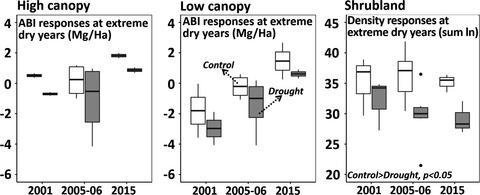当前位置:
X-MOL 学术
›
Journal of Vegetation Science
›
论文详情
Our official English website, www.x-mol.net, welcomes your feedback! (Note: you will need to create a separate account there.)
Effects of decadal experimental drought and climate extremes on vegetation growth in Mediterranean forests and shrublands
Journal of Vegetation Science ( IF 2.8 ) Pub Date : 2020-05-01 , DOI: 10.1111/jvs.12902 Daijun Liu 1, 2, 3 , Chao Zhang 1, 2 , Romà Ogaya 1, 2 , Marc Estiarte 1, 2 , Josep Peñuelas 1, 2
Journal of Vegetation Science ( IF 2.8 ) Pub Date : 2020-05-01 , DOI: 10.1111/jvs.12902 Daijun Liu 1, 2, 3 , Chao Zhang 1, 2 , Romà Ogaya 1, 2 , Marc Estiarte 1, 2 , Josep Peñuelas 1, 2
Affiliation

|
Increased drought combined with extreme episodes of heatwaves is triggering severe impacts on vegetation growth, particularly for plant communities in arid and semiarid ecosystems. Although there is an abundance of short‐term field drought experiments in natural ecosystems, remaining knowledge gaps limit the understanding and prediction of vegetation growth to ongoing and future climate scenarios. Here, we assessed the impacts of long‐term (1999–2016) experimental drought (ca. −30% rainfall) on the vegetation growth of a Mediterranean high (H) and low (L)‐canopy forests and an early‐successional shrubland, as indicated by above‐ground biomass increment (ABI) and standing density, respectively. We found habitat context (impact of historical climate change, soil depth and successional status) of the study sites significantly affected the magnitude of climate impacts; there were synergistic effects of experimental drought and meteorological drought (Standardised Precipitation–Evapotranspiration Index, SPEI) as well as extreme dry years on vegetation growth. Long‐term experimental drought decreased the ABI for the two forest canopy types and the standing density for the shrubland. Water availabilities in winter–spring (SPEIs) were positively correlated with the ABI and standing density. Moreover, experimental drought decreased the vegetation growth in extreme dry years for the shrubland. We propose that future work not only study the vegetation dynamics with physiological, phenological and demographical changes in long‐term processes and across climate gradients, but also should explore the changes of multiple functions simultaneously (e.g. multifunctionality) under long‐term processes and extremes. This type of analysis of long‐term data is essential to understand and predict biodiversity loss, composition shifts, declines in ecosystem function and carbon budgets at temporal and spatial scales, to enable policy makers to design and implement strategies for the maintenance of sustainable ecosystem function under future climate change scenarios.
中文翻译:

年代际实验干旱和极端气候对地中海森林和灌木地植被生长的影响
干旱的加剧加上极端的热浪正在触发对植被生长的严重影响,特别是对干旱和半干旱生态系统中的植物群落。尽管在自然生态系统中有大量的短期田间干旱试验,但是仍然存在的知识空白将对植被生长的理解和预测限制在当前和未来的气候情景中。在这里,我们评估了长期(1999-2016年)实验性干旱(大约-30%降雨)对地中海高(H)和低(L)冠层森林以及早期灌木丛的植被生长的影响,分别由地上生物量增量(ABI)和站立密度指示。我们发现了栖息地的环境(历史气候变化的影响,研究地点的土壤深度和演替状态)显着影响了气候影响的程度;试验干旱和气象干旱(标准降水量-蒸散指数,SPEI)以及极端干旱年份对植被生长具有协同作用。长期实验干旱降低了两种林冠类型的ABI和灌木丛的站立密度。冬春季水的利用率(SPEIs)与ABI和站立密度呈正相关。此外,实验干旱降低了灌木地极端干旱年份的植被生长。我们建议,未来的工作不仅要研究长期过程中以及整个气候梯度中具有生理,物候和人口变化的植被动态,但也应同时探索长期过程和极端情况下多种功能(例如多功能性)的变化。此类长期数据分析对于了解和预测生物多样性的丧失,组成变化,生态系统功能的下降以及时空尺度上的碳预算至关重要,以使决策者能够设计和实施策略来维持可持续的生态系统功能在未来的气候变化情景下。
更新日期:2020-05-01
中文翻译:

年代际实验干旱和极端气候对地中海森林和灌木地植被生长的影响
干旱的加剧加上极端的热浪正在触发对植被生长的严重影响,特别是对干旱和半干旱生态系统中的植物群落。尽管在自然生态系统中有大量的短期田间干旱试验,但是仍然存在的知识空白将对植被生长的理解和预测限制在当前和未来的气候情景中。在这里,我们评估了长期(1999-2016年)实验性干旱(大约-30%降雨)对地中海高(H)和低(L)冠层森林以及早期灌木丛的植被生长的影响,分别由地上生物量增量(ABI)和站立密度指示。我们发现了栖息地的环境(历史气候变化的影响,研究地点的土壤深度和演替状态)显着影响了气候影响的程度;试验干旱和气象干旱(标准降水量-蒸散指数,SPEI)以及极端干旱年份对植被生长具有协同作用。长期实验干旱降低了两种林冠类型的ABI和灌木丛的站立密度。冬春季水的利用率(SPEIs)与ABI和站立密度呈正相关。此外,实验干旱降低了灌木地极端干旱年份的植被生长。我们建议,未来的工作不仅要研究长期过程中以及整个气候梯度中具有生理,物候和人口变化的植被动态,但也应同时探索长期过程和极端情况下多种功能(例如多功能性)的变化。此类长期数据分析对于了解和预测生物多样性的丧失,组成变化,生态系统功能的下降以及时空尺度上的碳预算至关重要,以使决策者能够设计和实施策略来维持可持续的生态系统功能在未来的气候变化情景下。

























 京公网安备 11010802027423号
京公网安备 11010802027423号